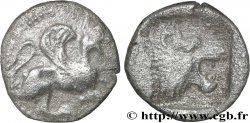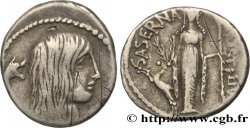v41_0057 - SICILY - SICULO-PUNIC - LILYBAION Tétradrachme
MONNAIES 41 (2009)
Starting price : 650.00 €
Estimate : 1 200.00 €
Realised price : 785.00 €
Number of bids : 4
Maximum bid : 946.00 €
Starting price : 650.00 €
Estimate : 1 200.00 €
Realised price : 785.00 €
Number of bids : 4
Maximum bid : 946.00 €
Type : Tétradrachme
Date: c. 325 AC.
Mint name / Town : Machanat (Le Camp), Lilybée
Metal : silver
Diameter : 24,5 mm
Orientation dies : 6 h.
Weight : 17,02 g.
Rarity : R2
Coments on the condition:
Exemplaire sur un flan épais, bien centré des deux côtés, un peu court au revers sur la légende et le col du cheval. Portrait magnifique, bien venu à la frappe et de joli style. Petite tête de cheval. Très jolie patine de collection avec des reflets mordorés
Catalogue references :
Obverse
Obverse legend : ANÉPIGRAPHE.
Obverse description : Tête de Melqart (Héraklès) imberbe à droite, coiffée de la léonté nouée sous le cou.
Reverse
Reverse legend : LETTRES PUNIQUES (MHSBM = MACHANAT) HORS CHAMP.
Reverse description : Tête et cou de cheval à gauche ; derrière un palmier.
Commentary
Mêmes coins que l’exemplaire du British Museum provenant du SNG Llyod (n° 1646) venant lui-même du trésor de Cefalu (IGCH 2154) découvert en 1925 qui contenait 60 monnaies d’argent et aurait été enfoui vers 300 avant J.-C.








 Report a mistake
Report a mistake Print the page
Print the page Share my selection
Share my selection Ask a question
Ask a question Consign / sell
Consign / sell










